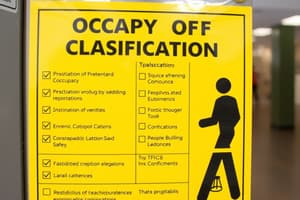Podcast
Questions and Answers
What is the definition of Assembly Occupancies - Group A?
What is the definition of Assembly Occupancies - Group A?
- A group for the gathering of persons for various activities (correct)
- A group for storage purposes
- A group for sleeping purposes
- A group for educational purposes
What includes buildings occupied by more than five children older than 2½ years who receive educational and care services?
What includes buildings occupied by more than five children older than 2½ years who receive educational and care services?
Group E, Day care facilities
What is the term for the Maximum Allowable Quantity of hazardous materials?
What is the term for the Maximum Allowable Quantity of hazardous materials?
MAQ
Infant care facilities may be classified as a Group I-4 occupancy.
Infant care facilities may be classified as a Group I-4 occupancy.
What classification includes assembling, disassembling, and manufacturing operations that are not classified as high-hazard?
What classification includes assembling, disassembling, and manufacturing operations that are not classified as high-hazard?
Which of the following are examples of Group I-2 occupancies?
Which of the following are examples of Group I-2 occupancies?
What occupancy group includes storage spaces that are accessory to another occupancy?
What occupancy group includes storage spaces that are accessory to another occupancy?
Group R is used for ______ purposes.
Group R is used for ______ purposes.
Match the following examples with their occupancy group:
Match the following examples with their occupancy group:
High-hazard Group H includes uses that do not involve physical or health hazards.
High-hazard Group H includes uses that do not involve physical or health hazards.
Which of the following are classified under Group A-2 occupancies?
Which of the following are classified under Group A-2 occupancies?
Flashcards are hidden until you start studying
Study Notes
Occupancy Classification Groups
-
Assembly Occupancies (Group A): Structures used for gathering people for civic, social, or recreational purposes, including food consumption or awaiting transportation.
-
Group E (Day Care Facilities): Buildings serving more than five children aged 2½ years and older for educational or supervision services for less than 24 hours.
-
Infant Care Facilities: Typically classified as Group I-4 but may be Group E if serving under 100 children aged 2½ years or less, with direct exits to the exterior.
-
Factory and Industrial Group F: Includes operations such as manufacturing, assembling, and processing that do not fall under high-hazard or storage classifications.
-
High-hazard Group H: Involves manufacturing or storage of hazardous materials in exceeding quantities, categorized into H-1 through H-5.
-
Hazardous Materials Storage: Classified as outdoor storage if located on roofs or canopies.
-
Physical Hazards: Includes risks from burning, detonations, or accelerated burning processes.
-
Health Hazards: Results from materials where a single exposure may incapacitate individuals.
-
Maximum Allowable Quantity (MAQ): Defined as the limit for hazardous materials in control areas.
-
Control Area: Designated spaces in a building with limited amounts of hazardous materials based on MAQ.
-
Institutional Group I: Provides care to individuals needing assistance or those detained for correctional purposes, subdivided into Group I-1 through I-4.
-
Residential Group R: Occupancies that provide sleeping accommodations with four subdivisions based on occupant familiarity: R-1, R-2, R-3, and R-4.
-
Storage Group S: Buildings primarily used for storage that are not hazardous.
-
Accessory Storage Spaces: Storage areas that are part of another occupancy classification.
-
Incidental Uses: Associated uses that may pose higher hazards, requiring separations or protection measures, like laundries and paint shops.
Examples of Occupancies
-
Group M Occupancies: Includes retail spaces like department stores, markets, and drug stores accessible to the public.
-
Group I-4 Occupancies: Consists of adult and child daycare facilities.
-
Group I-3 Occupancies: Encompasses correctional facilities such as prisons, jails, and detention centers.
-
Group I-2 Occupancies: Includes hospitals, psychiatric hospitals, nursing homes, and detox facilities.
-
Group I-1 Occupancies: Features facilities like group homes, assisted living, and halfway houses (not applicable in California).
-
Group E Occupancies: Daycare centers and educational institutions for elementary and secondary levels.
-
Group B Occupancies: Commercial facilities including banks, animal hospitals, and hair salons.
-
Group A-1 Occupancies: Structures for performances like theaters, concert halls, and studios with audiences.
-
Group A-2 Occupancies: Establishments for dining and entertainment, such as restaurants and nightclubs.
-
Group A-3 Occupancies: Includes art galleries, churches, and other assembly spaces.
-
Group F-1/SI Occupancies: Involves production and assembly of products like automobiles and bakery goods.
-
Group F-2/S-2 Occupancies: Utilized for manufacturing less hazardous materials like glass products and brick.
-
Group H-1 Occupancies: Facilities managing explosive materials and detonable items.
-
Group H-2 Occupancies: Structures handling deflagration hazards, including flammable liquids and gases.
Studying That Suits You
Use AI to generate personalized quizzes and flashcards to suit your learning preferences.




